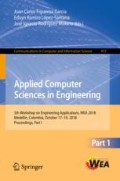Abstract
AdaBoost is an Artificial Intelligence algorithm widely used in classification problems with outstanding results in low complexity models. In this article, the prediction of the COLCAP series is carried out through the AdaBoost.RT algorithm with self-adaptive \(\varphi \). Firstly, the COLCAP index time series is analyzed in order to verify its stationarity by the unit root test. Exogenous information is used based on five time series of financial character, which were selected after performing a grey relational analysis and principal component analysis. To find optimal values of the algorithm, the variation of each value was executed. The results show that it is possible to predict the COLCAP index through AdaBoost using 48 weak classifiers resulting in MAPE = 1.247% and RMSE = 17.87. With a less complex model that uses two weak apprentices the results were MAPE = 1.403% and RMSE = 22.56.
Access this chapter
Tax calculation will be finalised at checkout
Purchases are for personal use only
References
Susruth, M.: Financial forecasting: an empirical study on box - Jenkins methodology with reference to the Indian stock market. 10(2), 115–123 (2017)
Huck, N., Guegan, D.: On the use of nearest neighbors in finance. Finance 26, 67–86 (2007)
Meade, N.: A comparison of the accuracy of short term foreign exchange forecasting methods. Int. J. Forecast. 18(1), 67–83 (2002)
Mahfoud, S., Mani, G., Reigel, S.: Nonlinear versus linear techniques for selecting individual stocks. In: Decision Technologies for Financial Engineering, pp. 65–75 (1997)
Chen, A.S., Leung, M.T., Daouk, H.: Application of neural networks to an emerging financial market: forecasting and trading the Taiwan stock index. Comput. Oper. Res. 30(6), 901–923 (2003)
Kodogiannis, V., Lolis, A.: Forecasting financial time series using neural network and fuzzy system-based techniques. Neural Comput. Appl. 11, 90–102 (2002)
Liu, S., Jingwen, X., Zhao, J., Xie, X., Zhang, W.: Efficiency enhancement of a process-based rainfall-runoff model using a new modified AdaBoost.RT technique. Appl. Soft Comput. J. 23, 521–529 (2014)
Alfaro, E., García, N., Gámez, M., Elizondo, D.: Bankruptcy forecasting: an empirical comparison of AdaBoost and neural networks. Decis. Support. Syst. 45(1), 110–122 (2008)
Wen, J., Zhang, X., Xu, Y., Li, Z., Liu, L.: Comparison of AdaBoost and logistic regression for detecting colorectal cancer patients with synchronous liver metastasis. In: 2nd International Conference on Biomedical and Pharmaceutical Engineering, ICBPE 2009 - Conference Proceedings (2009)
Liu, H., Tian, H., Li, Y., Zhang, L.: Comparison of four Adaboost algorithm based artificial neural networks in wind speed predictions. Energy Convers. Manag. 92, 67–81 (2015)
Hu, G.-S., Zhu, F.-F., Zhang, Y.-C., Yu, J.-L.: Study of integrating AdaBoost and weight support vector regression model. In: 2009 International Conference on Artificial Intelligence and Computational Intelligence, pp. 258–262 (2009)
de Colombia, B.V.: Metodología para el cálculo del íncide COLCAP. Technical report, Bolsa de Valores de Colombia, Bogotá (2016)
Perdomo, G.A.V., Sepúlveda, J.M.: Diseño y Evaluación de un Modelo de Pronóstico para el Índice COLCAP mediante Filtros de señal y Redes Neuronales Artificiales. In: Encuentro Internacional de Investigadores en Administración, number c, pp. 625–643 (2011)
Espinosa Acuña, O.A., Vaca González, P.A.: Fitting the classical and Bayesian GARCH models with student-t innovations to COLCAP index. In: Simposio Internacional de Estadística 2015, (c) (2015)
Freund, Y., Schapire, R.E.: A decision theoretic generalization of on-line learning and an application to boosting. Comput. Syst. Sci. 57, 119–139 (1997)
Schapire, R.E.: Explaining AdaBoost. In: Schölkopf, B., Luo, Z., Vovk, V. (eds.) Empirical Inference, pp. 37–52. Springer, Heidelberg (2013). https://doi.org/10.1007/978-3-642-41136-6_5
Wang, Y., Han, P., Xiaoguang, L., Renbiao, W., Huang, J.: The performance comparison of Adaboost and SVM applied to SAR ATR. CIE Int. Conf. Radar Proc. 00, 1–4 (2007)
Solomatine, D.P., Shrestha, D.L.: AdaBoost.RT: a boosting algorithm for regression problems. In: 2004 IEEE International Joint Conference on Neural Networks (IEEE Cat. No.04CH37541), vol. 2, pp. 1163–1168 (2004)
Autorregulador del Mercado de Valores de Colombia: Todo lo que un Inversionista debe saber sobre los nuevos Índices de la Bolsa de Valores de Colombia
de Colombia, B.V.: Índices bursátiles en línea
Brockwell, P.J., Davis, R.A.: Introduction to Time Series and Forecasting, 2nd Edn (2002)
Sallehuddin, R., Shamsuddin, S.M.H., Hashim, S.Z.M.: Application of grey relational analysis for multivariate time series. In: 2008 Eighth International Conference on Intelligent Systems Design and Applications, pp. 432–437 (2008)
Rencher, A.C.: Methods of Multivariate Analysis, 2nd edn (2002)
Tian, H.X., Mao, Z.Z.: An ensemble ELM based on modified AdaBoost. RT algorithm for predicting the temperature of molten steel in ladle furnace. IEEE Trans. Autom. Sci. Eng. 7(1), 73–80 (2010)
Author information
Authors and Affiliations
Corresponding author
Editor information
Editors and Affiliations
Rights and permissions
Copyright information
© 2018 Springer Nature Switzerland AG
About this paper
Cite this paper
Reyes Fajardo, L., Gaona Barrera, A. (2018). Application of the AdaBoost.RT Algorithm for the Prediction of the COLCAP Stock Index. In: Figueroa-García, J., López-Santana, E., Rodriguez-Molano, J. (eds) Applied Computer Sciences in Engineering. WEA 2018. Communications in Computer and Information Science, vol 915. Springer, Cham. https://doi.org/10.1007/978-3-030-00350-0_17
Download citation
DOI: https://doi.org/10.1007/978-3-030-00350-0_17
Published:
Publisher Name: Springer, Cham
Print ISBN: 978-3-030-00349-4
Online ISBN: 978-3-030-00350-0
eBook Packages: Computer ScienceComputer Science (R0)

